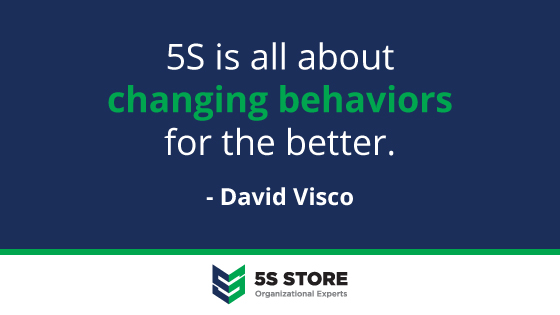
Why 5S, now? A case for sustaining your 5S initiatives no matter what else is happening around you

We often refer to 5S as a “program” or an initiative. But the truth is a little more subtle. There is a defined beginning, but no end-game. Sustained and continuous improvement is a hallmark of great organizations. That’s why what we do with our 5S programs right now is more important than ever.
5S is a business philosophy that infuses its practices, when applied correctly, into a company’s culture.
Global pandemics, furloughs due to budget cuts, and supply chain issues have more than a few organizations backburnering their 5S initiatives. As a longtime warehouse guy, I find this a troubling trend. Call me biased, but I find this moment to be a perfect example of why adhering to 5S basics is so important. When life is in constant motion, the 5S Methodology is an essential guardrail. It’s something like a set of bumpers on a bowling lane: Training us to stay on the most successful pathway.
When stress levels are high and budgets squeezed, it’s easy to forget why 5S is a necessity. But the truth is, how well your 5S program is working often correlates to how successful the company is.
Achieving more with fewer resources isn’t a new concept to a 5S practitioner.
– David Visco
5S principles are the most effective way I know to audit the health of company culture. It’s about way more than efficiency.
So what exactly is 5S?
The 5S Method is a standardized process that when properly implemented creates and maintains an organized, safe, clean, and efficient workplace. Improved visual controls are implemented as part of 5S to make any process violations obvious and easily detectable. 5S is often one element of a larger Lean initiative and promotes continuous improvement. The term “5S” specifically stands for:
- Seiri / Sort: Separating of the essential from the nonessential items,
- Seiton / Straighten: Organizing the essential materials where everything has its place,
- Seiso / Shine: Cleaning the work area,
- Seiketsu / Standardize: Establishing a system to maintain and make 5S a habit,
- Shitsuke / Sustain: Establishing a safe and sanitary work environment (Safety).
By following these five steps, we reduce waste in a variety of ways.
The eight forms of waste typically considered in 5S are:
- Overproduction – Producing more than required or producing parts faster than they can be used.
- Excessive Inventory – This can be a direct result of overproduction or it could be due to poor purchasing practices. Over purchasing supplies because we got a great deal sometimes is no deal at all.
- Inappropriate Processes – Waste happens through the use of the wrong tools. It can also happen by performing needless tasks. Using less efficient processes and tools can cause waste too.
- Waiting – Time and resources are wasted when waiting on parts, supplies, or information.
- Transportation – Excessive travel or movement of materials is waste.
- Unnecessary Motion – Any movement or motion that does not add value is waste.
- Defects – This form of waste is one of the worst of all. Defects can also create additional waste in the form of wait time.
- Untapped Employee Potential – Modern successful organizations create a culture where employee’s ideas are really heard and valued.
By relentlessly working to eliminate these wastes, we create stronger organizations. The 5S Principles are recognized in many industries as effective tools for improving workplace organization, reducing waste, and increasing efficiency.
(Learn more about what 5S is here.)

The longer we work in this new environment, the more obvious the need for 5S becomes.
As every company whose spent time on this journey knows, sustaining is the difficult part. Vigilance over time is not easy. We tend to slip back into old habits. Handwashing with the intentionality of a surgeon slips into a quick splash. We get into each other’s space for convenience, forgetting social distancing. Visual standards, continuous small improvements, and consistent audits help keep us on track.
Why backburning 5S initiatives now might backfire in the future.
There is a well worn English phrase that says: “When times get tough, the tough get going.”
I bet one or two of us used this line with our teams over the last six months. As budgets are slashed, tensions rise. It’s tempting to forget that efficiency, risk mitigation, teamwork, and systematic improvement are the cornerstones of financial success. Without this, we waste money, time, and resources. Most importantly, we waste the goodwill of our people–as errors occur and fingers are pointed. 5S helps us to reduce the risk that the stresses of a difficult year will turn into significant errors, delays, and malfunctions.
We recommit to our 5S initiatives to reinforce our commitment to our teams and their safety.

Are we truly committed to the 6th ‘S’ – Safety?
I made my first visit to a pharmacy, in a post-COVID world, in the Spring. It was a common chain and few things were different about the experience. Sure, we were wearing masks but I could still see that the cashier was smiling from the twinkle in her eyes.
Pleasantries were still spoken. The social distancing didn’t seem to change much, except when standing in line. That’s where I noticed the floor markings so familiar to me. Where many others might find these types of visual queues new, it made me smile with a familiar reminder about why I do what I do: 5S is ultimately about people.
In every warehouse, manufacturing facility, or humble gymnasium I’ve been inside of, floor taping is used as a universally understood queue about where to go (or not) to stay safe. The lines on the floor at my local pharmacy do the same.
5S tactics ultimately help us come together–whether or at work or at the store–in safe and productive ways.
We want people to be safe at work. And, safety is not only about social distancing during a pandemic or avoiding a tripping hazard. It’s also about job security, team cohesion and the comfort it gives us humans to know what the rules are.

At the end of the day, 5S is a powerful indicator of how an organization’s culture is manifesting day-to-day.
We believe that sustaining your 5S program is more important now than ever. As every consultant and practitioner will tell you, your program is only as good as your communication and consistency. Sustaining is difficult not because we are lazy or inept. It is difficult because we are human. And humans want to feel seen, safe and served. If we’re doing those things well, we will not only have strong 5S initiatives. We will have strong cultures too. And, as every strong leader will tell you, our company’s culture will determine whether we get going or fizzle out in tough times like these.

